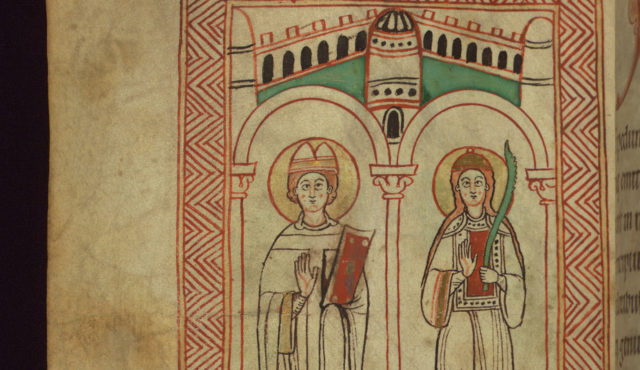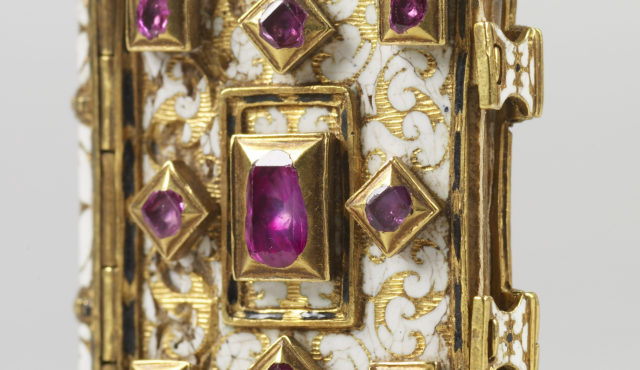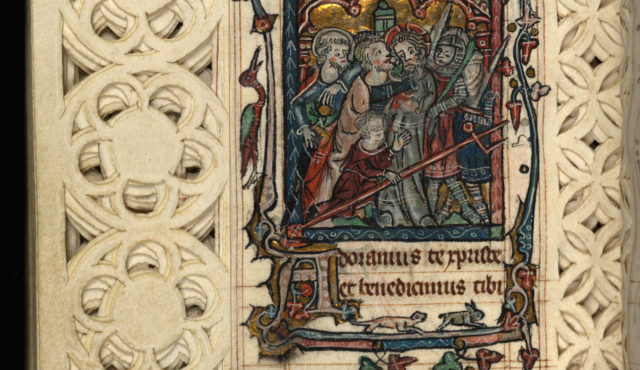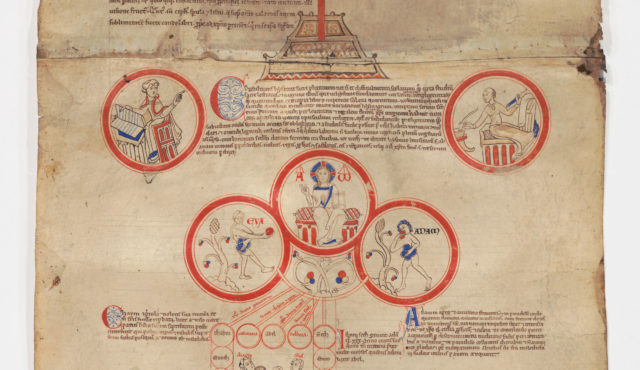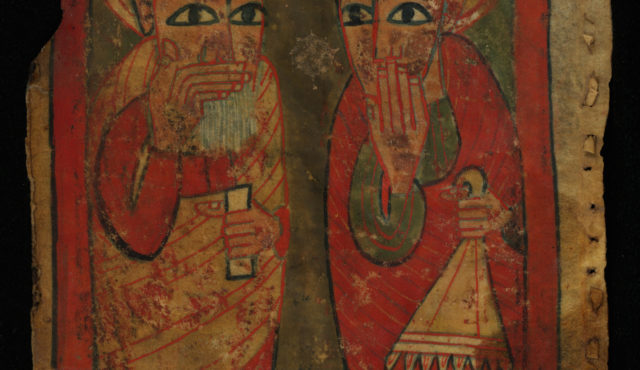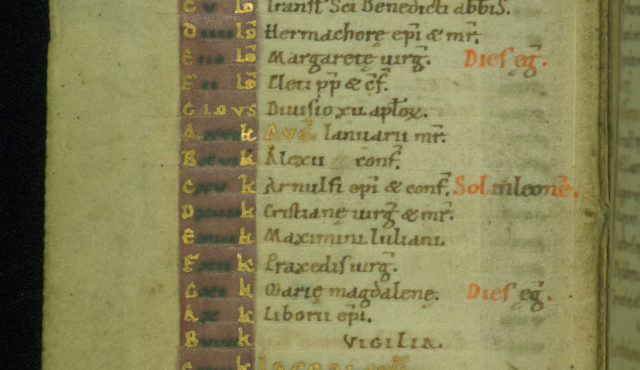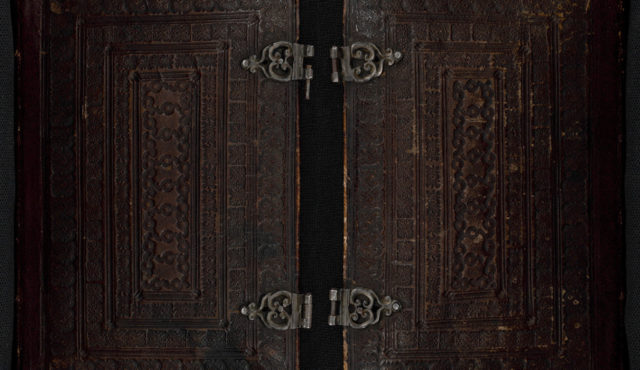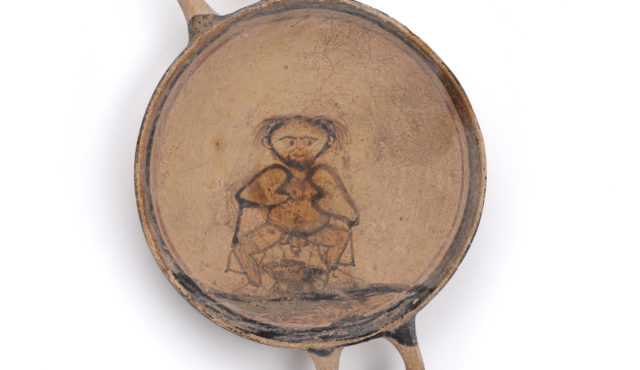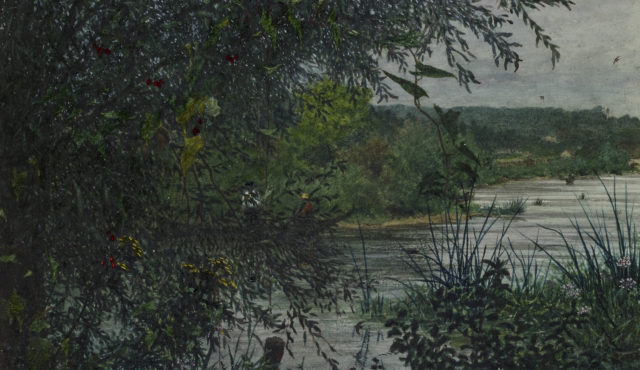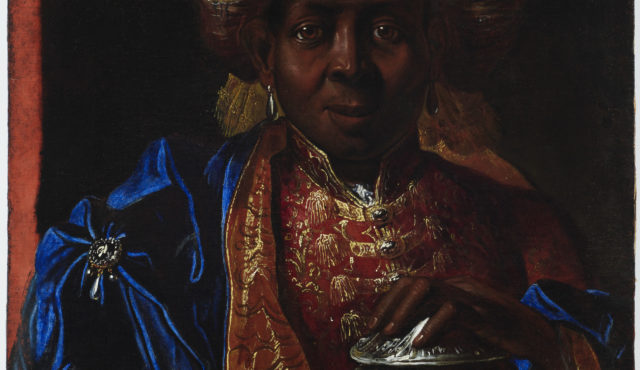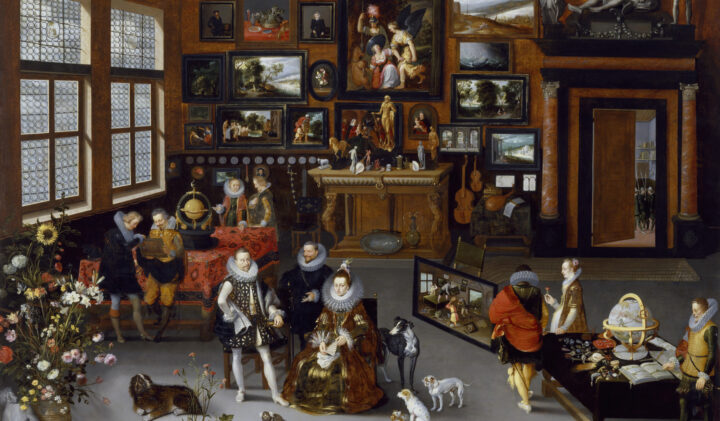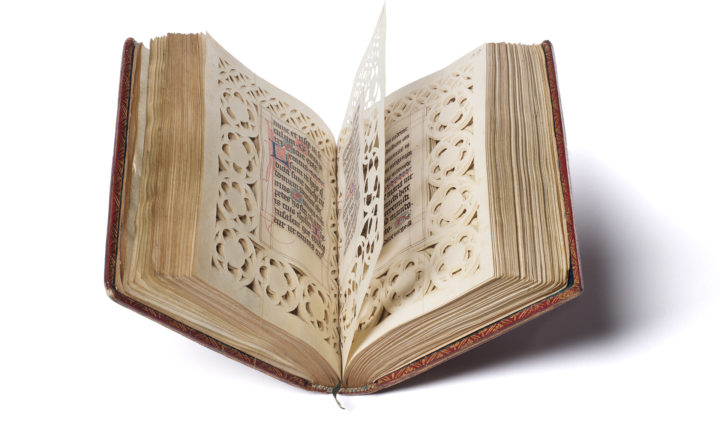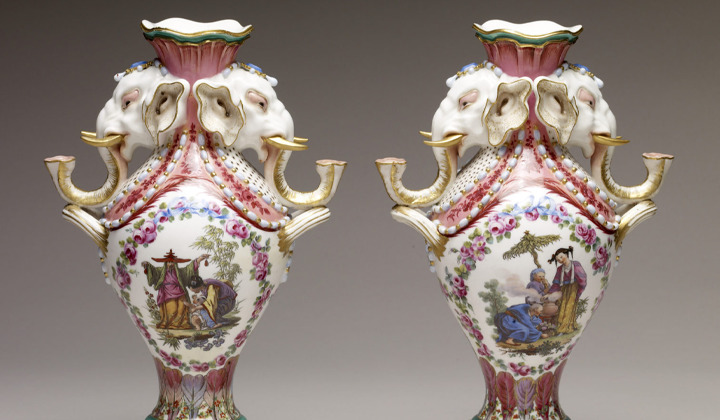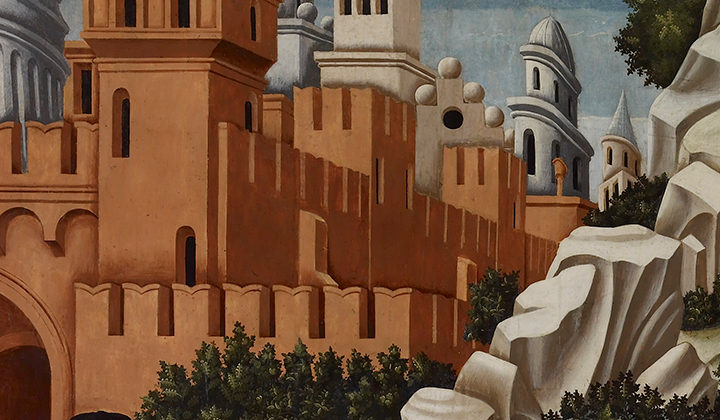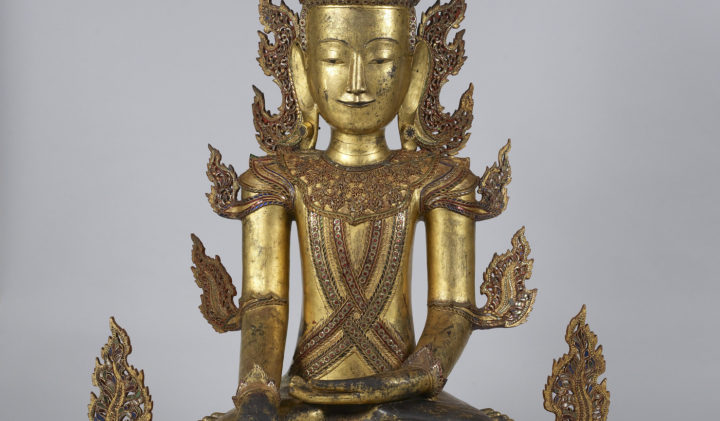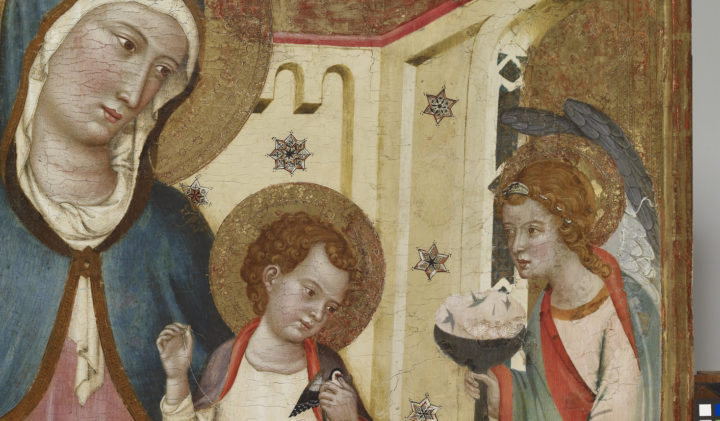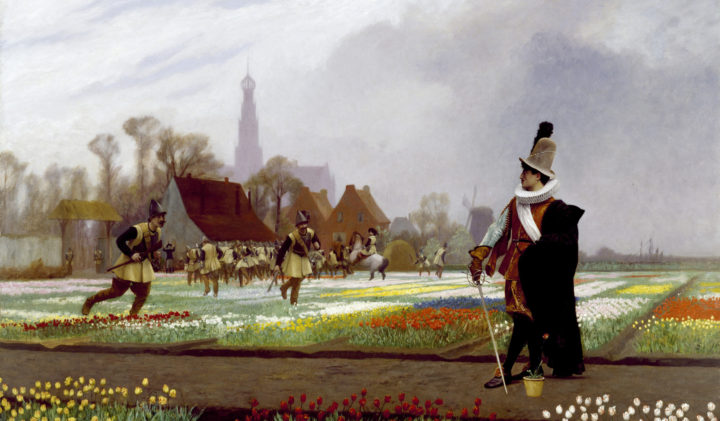“For the letter is a body whose life is, in truth, the spirit.”[1]
– Gregory the Great
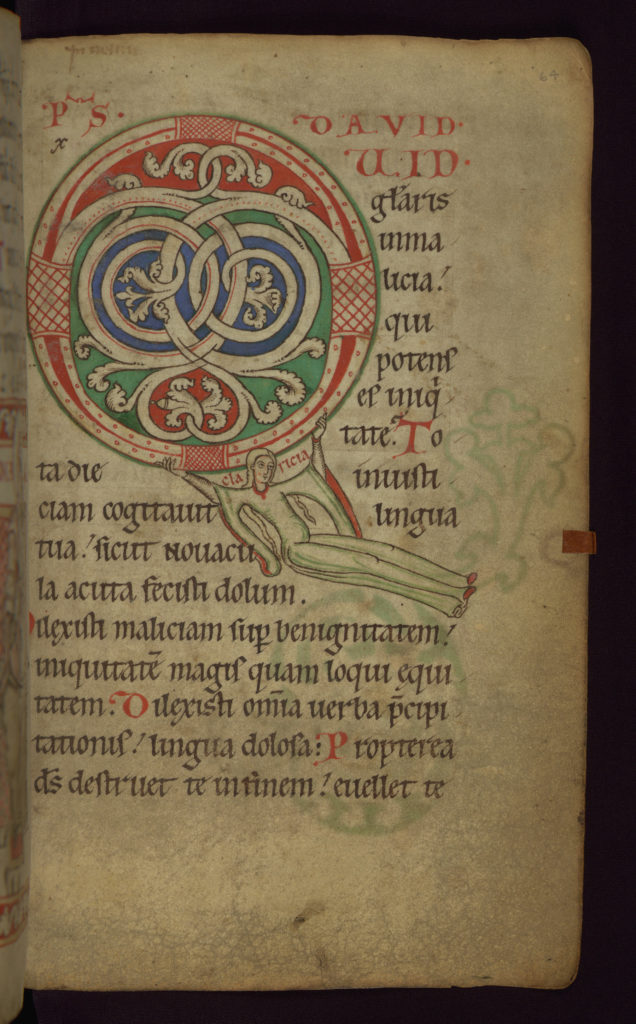
Nuns of the Abbey of St. Ulrich and St. Afra, “Claricia” as part of an initial Q, Claricia Psalter, Germany (Augsburg), late twelfth–early thirteenth century, ink and pigment on parchment. The Walters Art Museum, Baltimore, acquired by Henry Walters, by 1931, acc. no. W.26, fol. 64r
Ever since Dorothy Miner featured it in her seminal work on medieval women artists, the image of a young woman identified as Claricia in Walters manuscript W.26 has figured prominently in discussions of the place of women as makers of art in the medieval period (fig. 1).[2] When art historians consider her in conjunction with other apparent self-portraits in which scribe-illuminators present themselves within letters, Claricia makes sense as the artist-scribe responsible for the page.[3] As her body forms the tail of the letter, she is visually assimilated into the letter Q which initiates Psalm 51: the red and green coloring of her clothes matches the bowl of the letter and her flowing hair resonates with the curling tendrils of the acanthus pattern in the center of the letter. This would seem clearly to be a craftswoman identifying herself with the product of her labor.
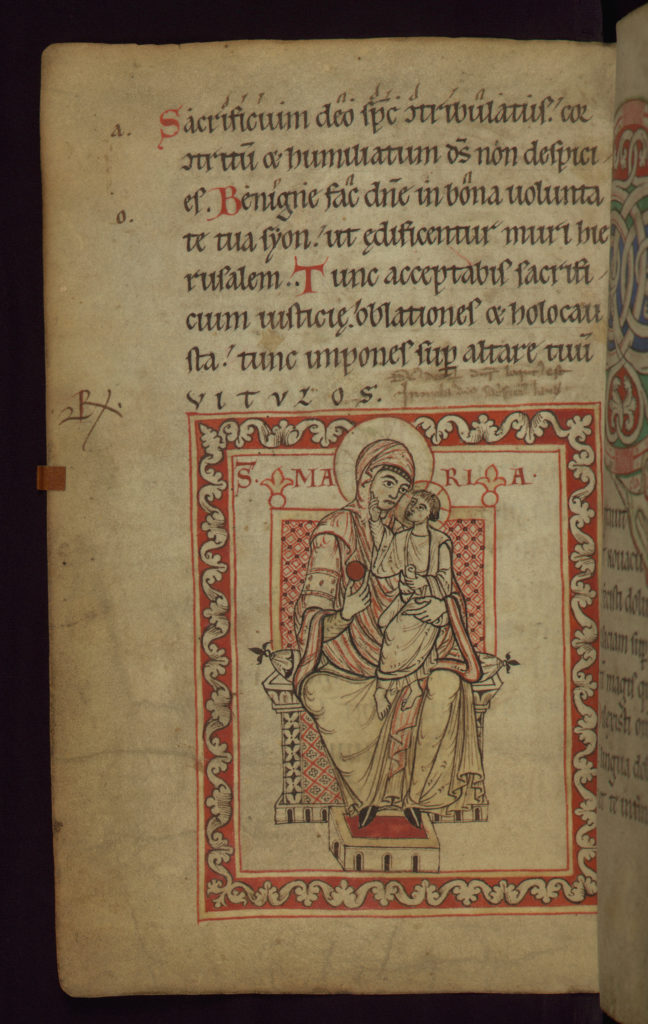
Virgin and Child, Claricia Psalter, acc. no. W.26, fol. 63v
As sensible as it is to see this as a self-portrait, there are important difficulties with such a reading, particularly when the painting is viewed in its manuscript context. One of them, first raised by Jonathan Alexander, is that this would seem to be a rather unusual psalm for Claricia to identify herself with.[4] While there was a broad and long-standing tradition of marking Psalms 1, 51, and 101 with decorative flourishes and imagery, it is relatively rare for images of scribes or donors to accompany Psalm 51. This may be because, as Alexander noted, Psalm 51 is composed mostly of invective. “Why dost thou glory in malice, thou that art mighty in iniquity?,” asks the opening verse that Claricia helps to form. The psalm continues: “All the day long thy tongue hath devised injustice: as a sharp razor, thou hast wrought deceit. Thou hast loved malice more than goodness: and iniquity rather than to speak righteousness. Thou hast loved all the words of ruin, O deceitful tongue. Therefore will God destroy thee forever.”[5] Based on this tenor of the psalm, Alexander speculated that perhaps Claricia is being presented not as a scribe worthy of remembrance and praise, but as a sinner subject to opprobrium.[6] Pierre-Alain Mariaux, in concurring with this assessment, noted moreover that the image, when viewed as part of an opening, presents Claricia as facing away from the image of the Virgin and Child on the facing page, an unusual break with medieval artistic decorum (fig. 2).[7] In Mariaux’s reading, her name is included not to bring her forward as a maker worth remembering and honoring, but as a prideful woman who prized her individual desires over the good of the community.[8]
Claricia meeting the Virgin and Child (animated), Claricia Psalter, acc. no. W.26, fols. 63v‒64r
The questions about how Claricia is being characterized change, however, when we recognize that the images of Claricia and the Virgin and Child come face to face when the book closes (fig. 3). A careful observation of the pages indicates that this fortuitous meeting was thoughtfully staged. The leaves are both within the same complete, eight-folio gathering, and while additional leaves were appended to the beginning and to the end of the manuscript early in the thirteenth century, no changes were made to this quire, and the manuscript has not been rebound or otherwise altered since.[9] The visual evidence is even more compelling. First, there is the very presence of the Virgin and Child, which is unusual in its placement here within the manuscript. While Marian imagery is common in twelfth- and thirteenth-century psalters, Mary does not appear between Psalms 50 and 51 in any other psalter, appearing more commonly in prefatory imagery. Nor is it common for devotional images of any import to occupy the bottom half of the page beneath the end of the previous psalm. The image of Claricia is also carefully contrived to make the most of the meeting: her open arms embrace the Virgin and Child as her legs lift into the Virgin’s arms, as though she is hopping in Mary’s lap for a group hug. Such physical interaction is consonant with the image of the Virgin and Child, in which the child touches his mother’s chin, a common gesture in other representations of the pair (fig. 2). If Claricia is being brought forward for opprobrium, why, then, would she be allowed to embrace Mary and Jesus when the book closes?
Kathryn A. Smith, noting the meeting of Claricia and the Virgin and Child in her critique of Mariaux’s essay, argued that his identification of Claricia with the iniquitous behavior described in the psalm might be not so much invective as a profession of humility.[10] “Closings” such as this have been noted before by David Ganz and by Alexa Sand, who have identified other instances when a mortal figure—significantly often the donor or honorand of a manuscript—comes into direct contact with the divine.[11] For example, Sand describes how, in the Gospels of Henry II from the early eleventh century, the adduced figures of Henry and Mary would come together as the pages closed together, such that the king would place the book he holds into her hands.[12] The Claricia closing differs slightly from the cases identified by Ganz and Sand in that it is transformative: rather than increasing the degree of contact between the votary and the divine, the closing in Claricia marks a distinct altering of the relationship. Claricia changes from turning her back on the Virgin and Child to emphatically embracing them. What we have is perhaps not so much an expression of humility but perhaps something closer to conversion.
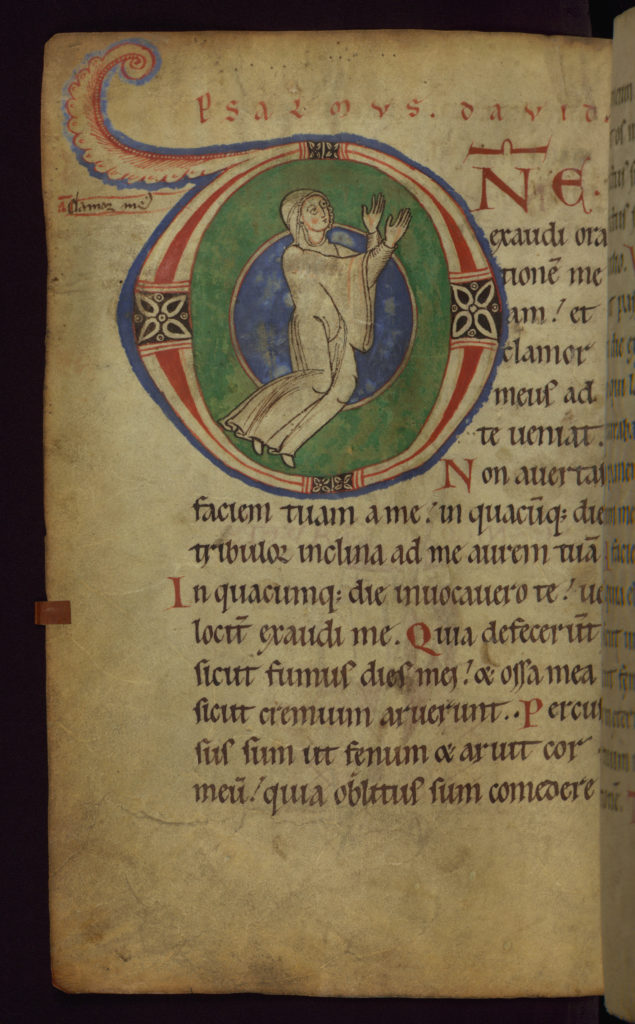
Initial D with Orant nun, Claricia Psalter, acc. no. W.26, fol. 115v
The power of the Claricia image comes into sharper focus when it is considered in relation to the other paintings in the book. On folio 115v (fig. 4), we find a woman in a nun’s habit in the center of the D that initiates Psalm 101. Her knees are bent, her arms open and extended, and her face and eyes turn upward: a clear posture of prayer or perhaps even adoration. But if we had to observe Claricia traversing the space of the opening to find what she desires, here we have to follow the nun’s gaze outside the confines of the book, to consider that which is ultimately unseeable. I think we can see that distinction being figured here not only in the dress of the two women, but also in their formal setting. As against the energetic vine scrolls in the Q that wend through and around each other, the D is designed much more simply, with the interior marked only by a simple blue circle outlined in red and bare parchment. The basic geometry of the ornament reflects a subtly different treatment of space: the nun seems not so much to kneel as to float within the barely defined space of the letter, whereas Claricia grasps the Q with both hands, her occluded thumbs denoting the form as having substance and existing within three dimensions. If Claricia is identified with the substance of the book—its script—the nun has entered into the space of those words and seems poised to be moving from there to somewhere beyond the space of the book.
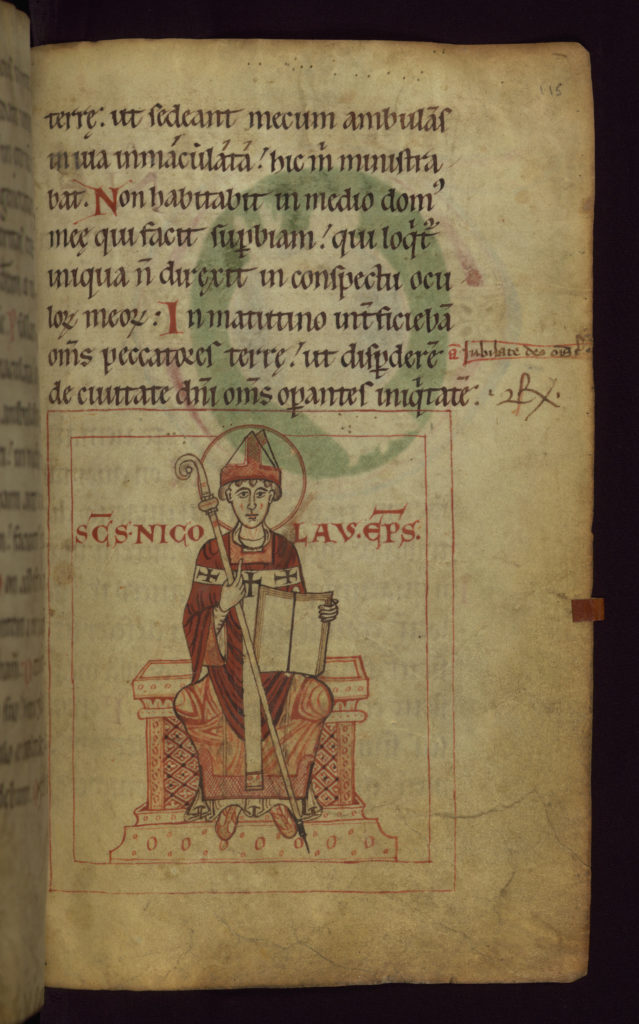
Saint Nicholas, Claricia Psalter, acc. no. W.26, fol. 115r
As with the image of Claricia on folio 64r, the nun’s meaning is enriched by an accompanying devotional image, in this case a representation of Saint Nicholas which appears on the recto of the page (fig. 5).[13] Once again, the image is placed unconventionally at the bottom of the page, and although he is depicted conventionally as a bishop, Nicholas’s gesture of pointing upward while holding an open book is intriguing and unusual within his common iconography. The gesture could be seen as a visual reminder to direct one’s thoughts heavenwards while reading sacred scripture, an exhortation that the nun dutifully responds to on the verso of the page. These two women could thus be read as presenting a kind of dialectic between matter and spirit in devotion, based on a clear distinction between a markedly corporeal devotion in the first and a more intellectual practice in the second. This distinction is offered by the two companion images, where the intimate physicality of the Virgin and Child can be contrasted to the emphasis on word and earthly transcendence by Nicholas, and to the two women, where Claricia’s exuberant gestures stand in counterpoint to the nun’s reserved demeanor.
Interestingly, this distinction between flesh and spirit can also be seen in the relationship of the figures to their respective letters. Medieval sign theory was emphatic on the distinction between the sensorial qualities of signs and their intelligible meanings. Throughout the Middle Ages, language was understood in terms that distinctly opposed the fleshly and material nature of its transmission—the tongues, lips, and ears of speech, or the hands, pens, pigments, parchment, and eyes of writing—with the incorporeal mental nature of its meaning. Interestingly, the relationship between material sign and immaterial meaning was often described in spatial terms. For example, Augustine, who remained the authority on this subject in the period when this manuscript was made, wrote that
the word that sounds outwardly is a sign of the word that shines inwardly, to which the name “word” more properly belongs. For that which is produced by the mouth of the flesh is the sound of the word, and is itself also called “word,” because that inner word assumed it in order that it might appear outwardly.[14]
That is, there is a perceptible exterior to a word and an intelligible interior. This distinction between form and meaning played out on the level of individual letters as well. Medieval scholars retained from the fourth and sixth century grammarians Donatus and Priscian a conception of written letters as having three “accidents”: nomen, the name by which a letter was called; figura, the customary shape it took; and potestas, the spoken sound which it represented.[15] As the Middle Ages progressed, and perhaps under the influence of an Augustinian emphasis on outer form and inner meaning, “potestas” came increasingly to be associated less with sound and more with meaning, with figura shifting to encompass all the sensorial aspects of a letter.[16] The relationship of letters to their meaning could even be cast in spiritual terms. As early as the seventh century, Virgilius Maro Grammaticus, a grammarian who was read into the twelfth century, stated that
just as a person consists of body, soul, and a kind of celestial fire, so a letter consists of its body, that is, its graphic, grammatical, and phonetic aspects, which are its structures and articulations, while it has a spirit in its signification and an inspiration in its superior reflection.[17]
A similarly metaphysical comment can be found in the thirteenth-century Tractatus de grammatica by Pseudo-Grosseteste, where the author identifies nomen, figura, and potestas with the philosophical concepts of species, substancia, and quidditas, respectively respectively, as they had been developed by Thomas Aquinas. Potestas thus becomes understood as something like the essence of a letter, while figura encompasses its material tangibility.[18] Claricia, who embodies the letter Q and who is also accompanied by her written name, is thus identified with the outward, visual, and corporeal nature of writing; her embrace of the image of the Virgin and Child can be seen as a similar fixation on the outward appearances of divinity.[19] The nun on 115v, meanwhile, floats within the letter as though she has been subsumed into its inner meaning and raises her hands in apprehension of God (domine) within.[20] Perhaps significantly, she is also near the top of the page, while Claricia swings near the bottom and could, in this light, be seen as dangling above the abyss.[21] Just as Aden Kumler has described the historiated initials of the St. Alban’s Psalter as “iconic space[s] filled with the search for God in Scripture and a figuration of the inward space of the soul,” this D presents the nun’s inward spiritual perception of the divine as a result of her intellectual understanding of the meaning of the letters in the book.[22] It might even be possible to recognize the design of the D on this page as deliberately recalling, in inverted form, the shape of a Q to reinforce this sense of transformation.[23]
The question remains of what, exactly, the relationship was (or is) between Claricia and the nun. Alexander and Mariaux seem to argue that Claricia is being “called out” for her bad behavior and could be seen in contrast to the prayerful nun. But it is hard to conceive of a scenario where a book’s original owner would desire a psalter that expends a fair portion of its decorative program on an image of invective. This is especially the case when one considers the private nature of the image: who but a few people would ever see this picture? Why make a point of maligning Claricia to such a small audience?
A more plausible, if ultimately unprovable, explanation is that the book presents the same woman at two stages of her life, as a young woman seduced by pleasures of the flesh and as a devout nun concerned only with matters of the spirit.[24] The written name on folio 64r secures Claricia’s identification with herself, while the placement of the nun is consistent with the tradition of representing patrons or intended recipients of a psalter at Psalm 101.[25] In light of this transformation, Mariaux would indeed be right to highlight the naming of Claricia, although it would be less a sign of opprobrium and more a recognition of the transformation from individualized to communal self that occurs when a person joins a monastic community. In a way, we could see the absence of a name identifying the nun as just as emphatic as the presence of a name in the earlier initial. The transformative nature of Claricia’s “closing” would serve as a reminder to the votary, every time she opened the book, that she had left her iniquitous behavior behind when she abandoned superficial readings of scripture and fell into the embrace of the divine. Such a biographical narrative would resonate also with the particular representation of the female martyr on folio 131v, which likely represents Saint Afra of Augsburg (fig. 6).[26] Afra is an early Christian martyr whose vita was codified in the Carolingian-era Confessio et passio Afrae.[27] There, she is described as moving from Cyprus to Augsburg with her family and soon after opening a house of ill-repute. She later converts to Christianity and transforms her brothel into a secret meeting house for Christians, particularly tending to other fallen women until she is discovered and martyred during the Diocletianic persecutions. Ulrich, standing to the left, was the tenth-century bishop who rebuilt a church in Augsburg dedicated to Afra and revived her cult, along with a convent dedicated to Saint Stephen. Afra has few specific attributes in the image, save a palm frond and a crown marking her martyrdom, so the fact that her hair is pictured unbound and flowing down both her shoulders is likely significant, and may be taken as an allusion to her pre-conversion life as a prostitute. Within the local iconography of this book, then, Claricia’s hair could be taken not only as a general sign of loose morals but also specifically, by way of her likening to Afra, as a sign of her indulgence in youthful transgressions before a dedication to Christian propriety.
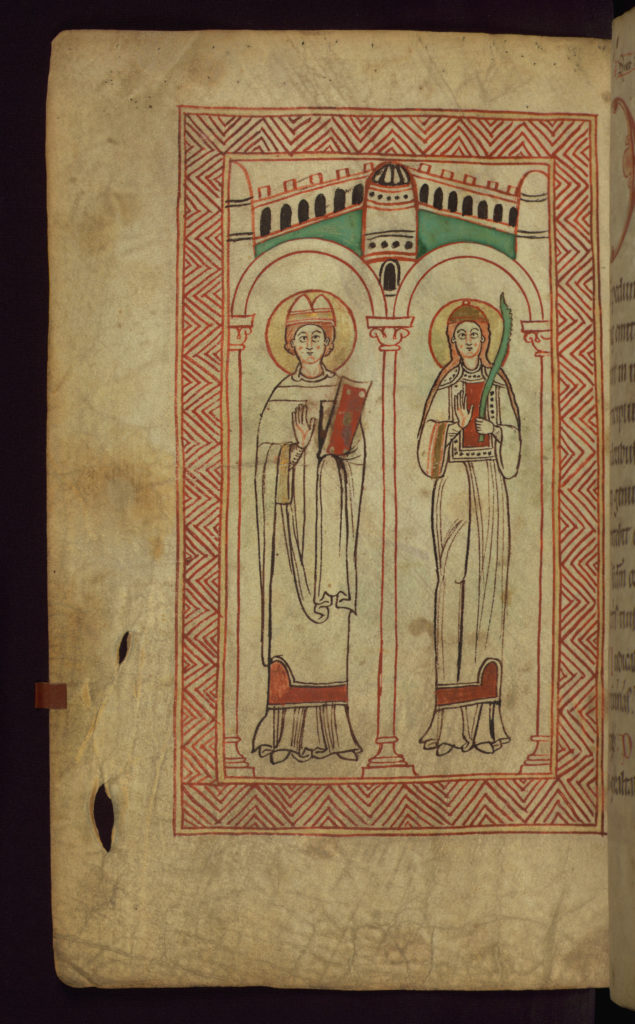
Saints Ulrich and Afra, Claricia Psalter, acc. no. W.26, fol. 131v
The figure of Afra also connects to another interesting iconographic parallel (or set of parallels) within the book: the red panel framed with a row of dots on her chest echoes the breastplate of Michael on the recto of the leaf (fig. 7). Michael’s breastplate, with a large central circle surrounded by four smaller ones at the corners, in turn mirrors very closely the book held by Ulrich on the verso, as well as the present cover of the psalter itself. While it must be conceded that this binding, while dating from soon after the manuscript’s making, is likely not original, the five-boss ornamentation of book covers was common at this time. Michael, of course, was common in psalter illustration as a reminder of the apotropaic quality of the psalms, particularly Psalm 109 which he accompanies here.[28] The visual assimilation of book to breastplate, and the formal similarity of the panel on Afra’s chest to both, presents a powerful image of scripture as a means of salvation and protection.
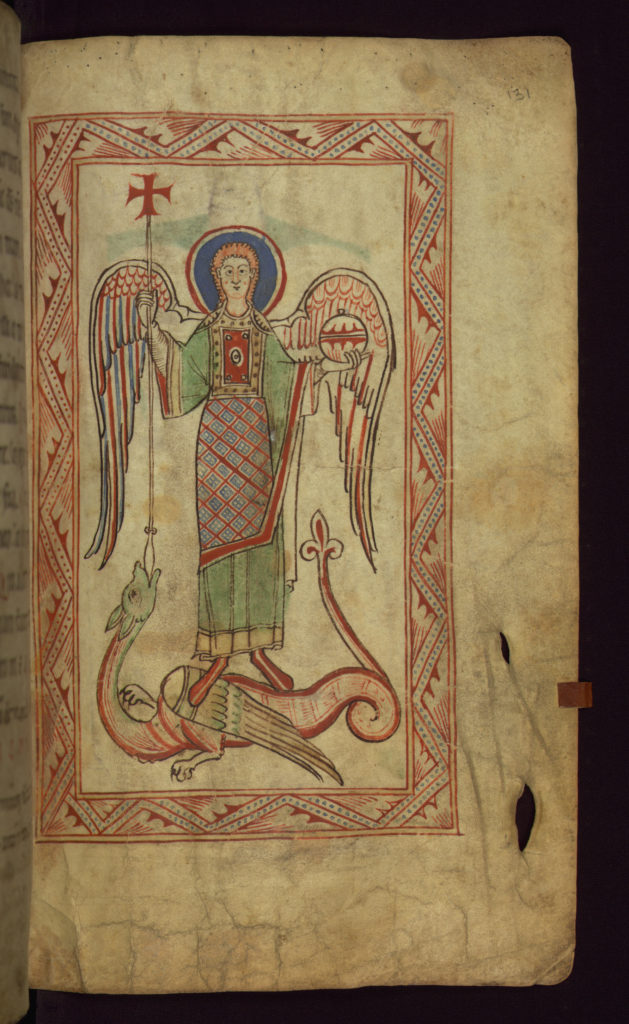
Archangel Michael, Claricia Psalter, acc. no. W.26, fol. 131r
Returning to the nun in the letter D, perhaps she is not only being assimilated to the divine word but also protected by it, as a kind of verbal cloistering. It is perhaps in this understanding of enclosure that the nun and Claricia are finally not contrasted but unified. When the book is opened, Claricia swings free, but when it is closed she is back in the embrace of the Virgin and Child. The open book held by Nicholas might then be seen not so much as an exhortation to read (the pages, after all, are blank) but as an invitation to enter a space of protection and enlightenment. Again, there is the contrast between matter and spirit, for Claricia’s enclosure is effected through the physical structure of the book, while the nun’s is accomplished virtually through an image, but we might finally resolve this distinction by recognizing, as monastic theology asserted, that physical cloistering made possible the protection of the soul.
Finally, we return to the question which must be asked but cannot be answered: did Claricia make this book? The Walters curatorial records state that the manuscript was made for, and probably by, Benedictine nuns of the abbey of saints Ulrich and Afra in Augsburg, and while many hands had a part in forming this book (especially in the additions later in the thirteenth century), the body of the psalter is almost entirely by one hand, and the figural and calligraphic decoration from the original campaign is highly stylistically consistent. The original psalter was likely a one-woman job, and it seems logical to assume that Claricia was that woman. But the lack of direct evidence is conspicuous: self-portraits from before and contemporaneous with this manuscript almost always show scribes and illuminators wielding the tools of their trade or accompanied by texts explicitly describing them as having made the book, and the absence of any such markers here is conspicuous.[29] Nonetheless, this discussion has shown that the original imagery of this manuscript is deeply invested in the relationship between the self and the book. It exhibits a bookishness—or “codicological consciousness,” as Martha Dana Rust has phrased it[30]—so insistent that it is hard to shake the feeling that Claricia was directly involved in its making, though we will likely never know for certain. Ultimately, though we may not be able to say for sure whether the book is by Claricia, it is surely of her, as she continues to dwell within it to this day.
This project has its roots in my time as the Zanvyl Krieger Curatorial Fellow at the Walters Art Museum, and William G. Noel encouraged me to pursue it. This essay developed for a time as a collaboration with Kathryn A. Smith, to whom this essay is deeply indebted but who bears no responsibility for any errors or misjudgments. Thank you as well to Lynley Herbert, Sonja Drimmer, the participants in the “Seeing Codicologically” workshop, the anonymous reviewers, and the editorial staff of the Journal.
[1] In librum I regum, 4:123 (PL 79:268; CCL 144:359): “Nam littera corpus est; huius vero corporis vita, spiritus.” Quoted and translated in Laurence de Looze, The Letter and the Cosmos: How the Alphabet Has Shaped the Western View of the World (Toronto: University of Toronto Press, 2016), 52.
[2] Dorothy Miner, Anastaise and Her Sisters: Women Artists of the Middle Ages (Baltimore: Walters Art Gallery, 1974), 11–12; and Annemarie Weyl Carr, “Women Artists in the Middle Ages,” The Feminist Art Journal 7 (1976): 5–9, and 26. Claricia is a fixture in the secondary literature on women in art history, featuring in such books as Whitney Chadwick, Women, Art, and Society (New York: Thames & Hudson, 1990), 53–54; and Carolyn Korsmeyer, Gender and Aesthetics: An Introduction (London: Routledge, 2004), 23.
[3] Laura Kendrick, Animating the Letter: The Figurative Embodiment of Writing from Late Antiquity to the Renaissance (Columbus: Ohio State University Press, 1999) Ohio: Ohio State University Press, 1999), 176–206; Michael Gullick, “Self-Referential Portraits of Artists and Scribes in Romanesque Manuscripts,” in Michael Gullick, ed., Pen in Hand: Medieval Scribal Portraits, Colophons and Tools (Walkern: Red Gull Press, 2006): 97–114; Erika Loic, “The Letter as Presence, Process, and Partnership: Mergers of Message and Medium in the Medieval Initial,” Visual Resources 36 (2020): 148–74.
[4] Jonathan J. G. Alexander, Medieval Illuminators and Their Methods of Work (New Haven: Yale University Press, 1992), 19–20.
[5] All biblical translations use the Douay-Rheims Bible (1582), which remains the closest English rendering of the Vulgate text that was in standard use through the medieval period.
[6] Alexander, Medieval Illuminators, 19–20.
[7] Pierre-Alain Mariaux, “Qui a peur de Claricia?” in Frédéric Elsig et al., eds., L’image en questions: Pour Jean Wirth (Geneva: Droz, 2013), 138–45; idem, “Women in the Making: Early Medieval Signatures and Artists’ Portraits (9th–12th c.),” in Therese Martin, ed., Reassessing the Roles of Women as ‘Makers’ of Medieval Art and Architecture, Vol. 2 (Leiden: Brill, 2015), 393–427, at 399–407. On the crucial importance of the opening as a visual unit, see Jeffrey F. Hamburger, “Openings,” in G. Kratzmann, ed., Imagination, Books & Community in Medieval Europe (South Yarra: Macmillan, 2009), 51–129.
[8] Mariaux, “Women in the Making,” 404–408.
[9] Sewing holes appear above both Claricia and the Virgin and Child, perhaps indicating that the images were veiled at one point and complicating the claim that Claricia is being brought into contact with the Virgin and Child when the book closes. When we inspected the manuscript together, Christine Sciacca, Curator of European Art, 300–1400 CE, at the Walters Art Museum, noted that the stitching holes are fairly irregular and stop short of the gutter, indicating that they were a later intervention added after the book had been bound.
[10] Kathryn A. Smith, “Medieval Women are ‘Good to Think’ With,” Journal of Art Historiography 9 (2013), 1–15. Prof. Smith and I engaged in several fruitful conversations about this manuscript in early stages of this project, and I am indebted and grateful to her for her insights.
[11] David Ganz, “Doppelbilder: Die innere Schau als Bildmontage im Frühmittelalter,” in Steffen Bogen and David Ganz, eds., Bilder, Räume, Betrachter : Festschrift für Wolfgang Kemp zum 60. Geburtstag (Berlin: Reimer, 2006), 34–53, at 46–49; Alexa K. Sand, Vision, Devotion, and Self-Representation in Late Medieval Art (New York: Cambridge University Press, 2014), 98–99.
[12] Sand, Vision, Devotion, and Self-Representation, 98–99.
[13] It is not immediately evident why Nicholas is represented here. A Benedictine convent dedicated to St. Nicholas and under the authority of the Abbey of SS. Ulrich and Afra was established just outside Augsburg in 1262, which would be well after the manuscript was originally made, but that formal establishment seems to have been preceded by the existence of a community of lay women in the same place. See Wilhelm Liebhart, “St. Nikolaus,” Stadtlexikon Augsburg, Wißner Verlag, https://www.wissner.com/stadtlexikon-augsburg/artikel/stadtlexikon/st-nikolaus/4902; and “St. Nikolaus bei Augsburg,” Klöster in Bayern, Haus der Bayerischen Geschichte, http://www.hdbg.eu/kloster/index.php/detail/geschichte?id=KS0469.
[14] De trinitate, 15.11.20: “Proinde verbum quod foris sonat signum est verbi quod intus lucet cui magis verbi competit nomen. Nam illud quod profertur carnis ore vox verbi est, verbumque et ipsum dicitur propter illud a quo ut foris appareret assumptum est.” Augustine, On the Trinity: Books 8–15, Gareth B. Matthews, ed., translated by Stephen McKenna (Cambridge: Cambridge University Press, 2002), 187.
[15] Mark E. Amsler, “Premodern letters and textual consciousness: From the pre-Socratics to the first grammatical treatise,” Historiographia linguistica 37 (2010): 279–319, at 284–85.
[16] See also Susan Rankin, Writing Sounds in Carolingian Europe: The Invention of Musical Notation (Cambridge: Cambridge University Press, 2018), 280, n. 8; and Gregor Vogt-Spira, “Vox und Littera: Der Buchstabe zwischen Mündlichkeit und Schriftlichkeit in der grammatischen Tradition,” Poetica 23 (1991): 295–327, at 326.
[17] Epitomae, 2.1: “Sicut enim homo plasto et affla et quodam caelesti igne consistit, ita et littera suo corpore (hoc est figura, arte ac ditione velut quisdam conpagibus arcubusque) suffunta est, animam habens in sensu, spiridonem in superiori contemplatione.” Quoted and translated in Amsler, “Premodern letters,” 300.
[18] Karl Reichl, ed., Tractatus de grammatica: Eine fälschlich Robert Grosseteste zugeschriebene spekulative Grammatik, with commentary (Vienna: Ferdinand Schöningh, 1976), 24.
[19] Ibid., 142.
[20] It is worth noting that this contrast between the sensorial and meaningful qualities of letters resonates with the distinctions of four different kinds of letters put forth by Saint Bernardino of Siena. As discussed at length by Martha Dana Rust, Bernardino contrasts the use of “middle letters” (i.e., writing) by mediocre minds against the mental letters “for those who desire to persevere always in contemplation.” See Martha Dana Rust, Imaginary Worlds in Medieval Books: Exploring the Manuscript Matrix (New York: Palgrave Macmillan, 2007), 38.
[21] Kathryn Smith suggested this distinction between high and low to me in conversation.
[22] Aden Kumler, “Handling the Letter,” in Kristen Collins and Matthew Fisher, eds., St. Albans and the Markyate Psalter: Seeing and Reading in 12th Century England, Studies in Iconography: Themes and Variations 2 (Kalamazoo, MI: Medieval Institute Publications, 2017), 87.
[23] My gratitude to the anonymous reviewer who suggested this reading.
[24] Mariaux offers this possibility as speculation but does not fully develop the idea. See Mariaux, “Qui a peur de Claricia?” 145.
[25] Nigel Morgan, “Patrons and their Devotions in the Historiated Initials and Full-Page Miniatures of 13th-Century English Psalters,” in Frank O. Büttner, ed., The Illuminated Psalter: Studies in the Content, Purpose and Placement of its Images (Turnhout: Brepols, 2004), 309–22.
[26] Although neither saint is specifically identified in the image, both appear in the calendar at the front of the book and inclusion of the pair would be consistent with the other indications of an Augsburg origin.
[27] “Conversio et passio Afrae,” in Bruno Krusch, ed., Passiones Vitaeque Sanctorum Aevi Merovingici et Antiquiorum Aliquot. Monumenta Germaniae Historica: Scriptores Rerum Merovingicarum 3 (Hannover : Hahnsche Buchhandlung, 1896), 41–64. See also Ruth Mazo Karras, “Holy Harlots: Prostitute Saints in Medieval Legend,” Journal of the History of Sexuality 1 (1990): 3–32, at 15–17 and 30–32.
[28] Kathleen M. Openshaw, “Weapons in the Daily Battle: Images of the Conquest of Evil in the Early Medieval Psalter,” The Art Bulletin 75 (1993): 17–38.
[29] See the many examples in Alexander, Medieval Illuminators; Kendrick, Animating the Letter; Gullick, “Self-Referential Portraits”; and Loic, “The Letter as Presence.”
[30] Rust, Imaginary Worlds in Medieval Books, 13–17 and passim.
